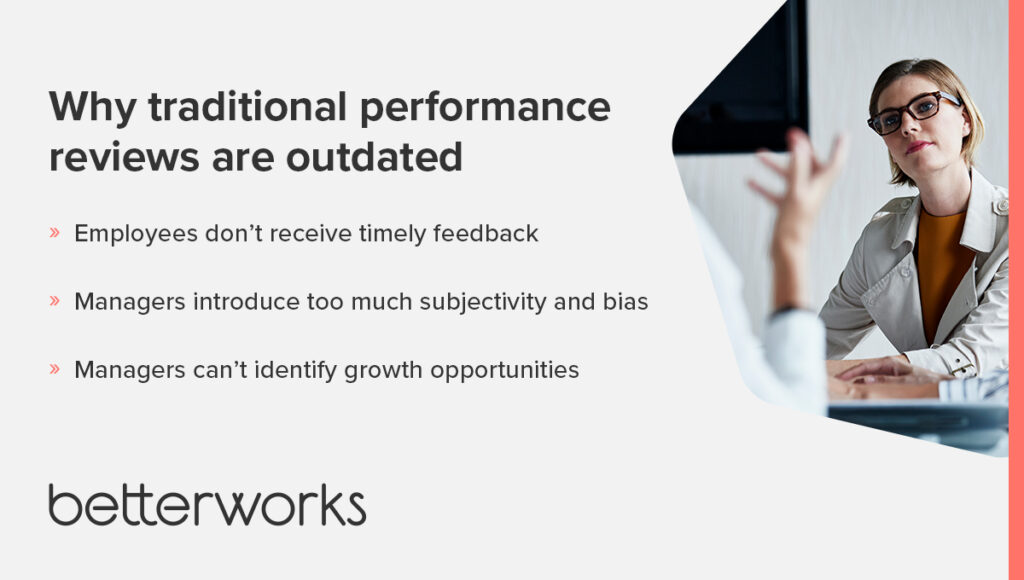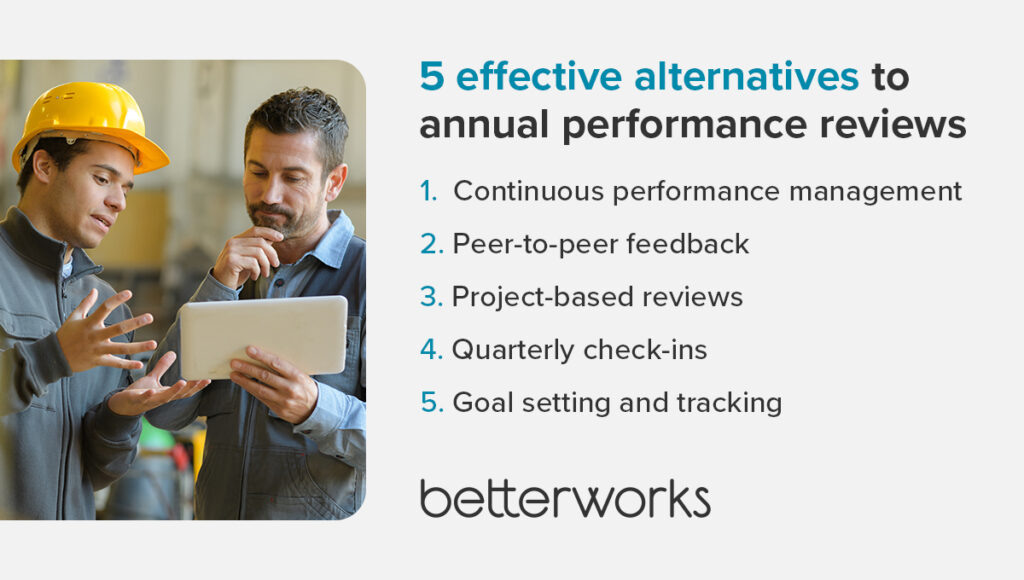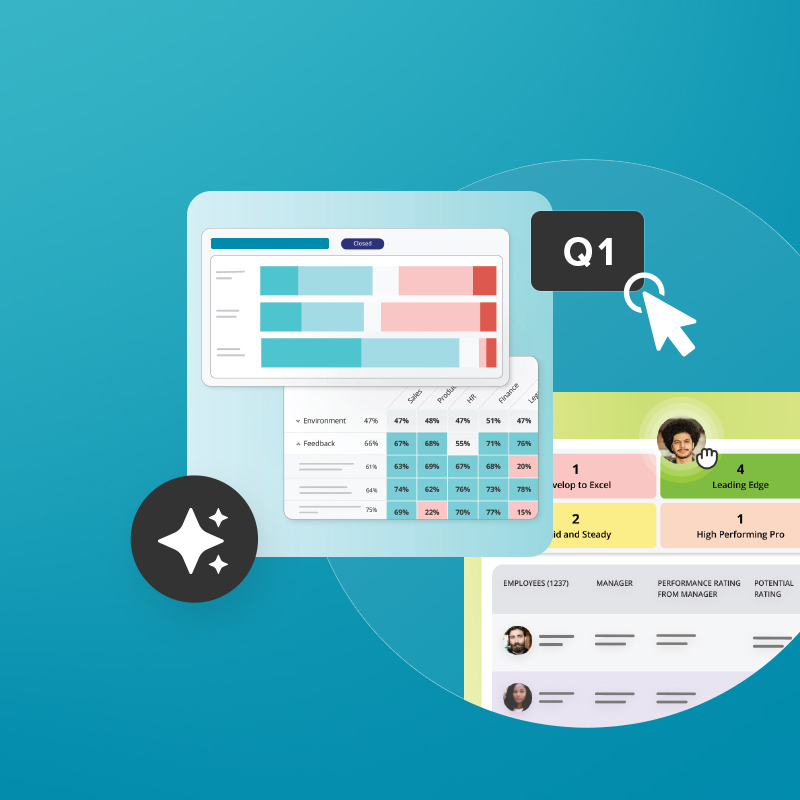- Why traditional performance reviews are outdated
- 5 effective alternatives to annual performance reviews
- How to decide which performance review alternative is right for you
- Implementing modern performance management solutions
- 4 benefits of modern performance management solutions
- Embracing modern performance management
Looking for an alternative to performance reviews? You’re not the only one rethinking that annual ritual. Once-a-year conversations are too late, too vague, and too disconnected from the work your people are doing every day.
As an HR leader, you need more than a checkbox process. You need a performance system that delivers real insights, supports meaningful development, and equips your managers to lead with clarity. But for most organizations, that’s still a work in progress. According to Betterworks’ 2025 State of Performance Enablement report, about half of employees say they love or like their current performance management process. The other half are indifferent, frustrated, or actively disengaged.
Moving past outdated reviews starts with smarter, more consistent practices — the kind that build trust, deliver business-ready data, and actually help people grow. Let’s explore five modern alternatives to traditional performance reviews that can help you get there.
Why traditional performance reviews are outdated
The traditional performance review process was designed for a different era, one in which change was slower, work was more predictable, and a yearly conversation could reasonably capture an employee’s contributions. Today’s work is fast, distributed, and deeply collaborative. Delayed feedback doesn’t just feel disconnected — it actively holds people back.
Employees don’t receive timely feedback
When feedback happens once a year, small problems go unaddressed and good work goes unrecognized. That delay creates frustration for employees and risk for the business. Without regular performance conversations, it’s easy for people to drift off course or double down on the wrong behaviors.
“Let’s say I’ve been doing something wrong for nine months, and you don’t tell me until the end of the year. I could have fixed that nine months ago and been doing so much better in my job,” says Caitlin Collins, organizational psychologist and program strategy director at Betterworks. “And now I’ve created a behavior pattern that’s going to be so much harder to break.”
Infrequent feedback leaves employees feeling unsupported and unsure of where they stand — not exactly the conditions for high performance.
“Let’s say I’ve been doing something wrong for nine months, and you don’t tell me until the end of the year. I could have fixed that nine months ago and been doing so much better in my job. And now I’ve created a behavior pattern that’s going to be so much harder to break.”
Caitlin Collins, program strategy director, betterworks
Managers introduce too much subjectivity and bias
When managers only assess performance once a year, it becomes challenging to maintain objectivity. . Recency bias, personal preferences, and unconscious assumptions creep in, especially when feedback hasn’t been documented or discussed along the way.
“Our brains rely on memory,” Caitlin says. “We’re cramming 12 months of the memory of someone, how they showed up and performed.”
Subjective reviews erode trust and credibility. And in enterprise settings, bias in performance reviews introduces unnecessary risk to decisions about compensation, promotion, and advancement. According to Betterworks’ 2023 State of Performance Enablement report, fewer than 1 in 3 employees see performance reviews as very fair and equitable.
Managers can’t identify growth opportunities
When check-ins are rare, managers miss key moments to coach and develop their teams. And without clear, continuous feedback, high-potential employees may disengage or move on.
This isn’t just a people problem — it’s a business problem. Organizations that fail to enable growth lose their best talent, create skill gaps, and slow down succession planning.

5 effective alternatives to annual performance reviews
If the annual review is no longer working, what’s a better path forward? It starts with a shift in mindset — from performance evaluation to performance enablement. The most effective organizations don’t wait for year-end to give feedback or discuss development. They embed conversations about employee performance into the rhythm of work.
Check out five effective alternatives to annual performance reviews that can help you build a more agile, aligned, and data-driven approach to managing your people.
Continuous performance management
Frequent check-ins between managers and employees are the foundation of a modern performance strategy. These conversations don’t have to be long or formal; what matters is that they happen regularly and focus on progress, blockers, and development.
“The true value of manager feedback happens when you can catch people when they can learn and have the right context,” Caitlin says. This approach promotes a more dynamic and responsive work environment, where employees feel supported and motivated to improve continuously.
Continuous conversations help employees course-correct early, stay aligned with goals, and feel more supported in their work. And when feedback is shared consistently, it becomes easier for HR to track performance trends and support broader talent strategies.
Peer-to-peer feedback
Feedback from coworkers can offer a richer, more complete view of performance, especially in cross-functional or matrixed environments. It also builds a culture of trust, collaboration, and shared accountability.
The Betterworks’ 2024 State of Performance Enablement report found that employees who receive good conversations and feedback are 3x more likely to feel they can perform their work. The 2023 report also makes clear that nearly 70% of employees want peer feedback from between 2-5 people and that half of employees say this feedback leads to very fair and equitable performance reviews.
This approach aligns well with modern talent strategies, which emphasize engagement and development as critical components for retaining top talent.
Project-based reviews
Rather than assessing performance once a year, project-based reviews capture feedback immediately after work is completed. This makes the input more relevant, more specific, and easier to act on.
Project-based reviews also help teams spot coaching opportunities in real time and give leaders visibility into how employees contribute across teams and initiatives.
Tying feedback to concrete actions employees recently performed improves learning outcomes. “There’s a positive element of creating behavior change, reinforcing development,” Caitlin says.
Quarterly check-ins
A quarterly rhythm of performance reviews gives managers and employees a consistent structure for reviewing progress, resetting priorities, and addressing challenges without waiting until year-end.
These conversations don’t replace informal feedback, but they create a regular checkpoint for deeper reflection, growth planning, and two-way alignment.
When check-ins are part of the culture, they make performance management feel less like a surprise and more like a partnership.
Goal setting and tracking
Well-defined, measurable goals are the backbone of effective performance management. They help employees focus on what matters and give managers a clear view of progress and impact throughout the year.
By implementing goal setting and tracking, you create a more agile, supportive work environment that drives better business outcomes and ensures everyone’s efforts contribute to the bigger picture. Then, with the right tools in place, HR can use goal data to inform decisions about promotions, compensation, and succession planning with greater confidence.
Tracking progress toward goals across the enterprise offers a more meaningful perspective on performance, Caitlin says. “What’s the impact my work has achieved based on my sphere of influence?” she asks. “A lot of that can be determined by goal achievement.” Seeing employees check off goals demonstrates tangible growth

How to decide which performance review alternative is right for you
Before you move away from annual performance reviews, get clear on what you need your performance process to do for your organization..
As an HR leader, you’re not just collecting feedback. You’re generating the performance data that drives decisions around compensation, promotions, talent mobility, and succession planning. The right alternative to performance reviews should help you capture those insights continuously — not just once a year under pressure.
Start by identifying:
- What performance signals do you need to make fair, informed decisions?
- How frequently do you need that data to support business cycles?
- Which conversations do managers and employees need to have to get there?
From there, you can build a process that puts performance management in service of business performance.
Implementing modern performance management solutions
Modern performance management isn’t about replacing one process with another. It’s about building a system that delivers timely feedback, tracks progress toward business goals, and helps your people grow — all in real time.
Technology plays a key role in making that possible. When performance conversations are supported by the right tools, they’re easier to manage, more consistent across teams, and more valuable for employees and leaders alike.

Enabling real-time feedback
Modern, AI-powered performance platforms make it simple for managers and employees to share feedback without waiting for formal cycles. Configurable templates, nudges, and integrations with everyday tools bring conversations into the flow of work — not once a year, but whenever it matters most.
That consistency builds a culture of continuous improvement. Employees always know where they stand. Managers can act as coaches, not just evaluators. And HR gets the performance visibility needed to support workforce planning at scale.
Enhancing goal setting and tracking
Intelligent goal-setting solutions help take the guesswork out of goal setting. When performance data is tied to goals and outcomes, you get a more accurate view of impact across the business. Managers can track progress without micromanaging. HR can use goal achievement to inform promotion and compensation decisions. And employees feel more connected to the big picture.
AI can help employees identify relevant goals, offer real-time progress tracking, and flag when objectives need to shift — all while aligning individual work to strategic priorities.
4 benefits of modern performance management solutions
Modern performance management solutions do more than streamline reviews — they transform how your organization supports growth, measures impact, and drives results. Here’s what you can expect when you leave the annual review behind.
Higher productivity
Modern performance management solutions significantly boost productivity by providing continuous, real-time feedback and goal tracking. That’s especially true for AI-enabled tools. Employees using them report greater efficiency and sharper alignment with goals. According to the Betterworks’ 2025 report, 90% of regular AI users say these tools help them meet goals more efficiently. And when goals are clear, tracked, and regularly discussed, performance improves across the board. The 2023 report reveals that self-reported productivity among employees who are very satisfied with their performance conversations is 40% higher than among employees who are rarely satisfied.
Increased employee engagement
Frequent feedback, clear goals, and better coaching lead to stronger relationships and more engaged teams. When performance management feels helpful — not punitive — employees stay motivated, connected, and focused on growth.
Data-enabled decision making
Modern platforms capture performance data in real time, giving HR leaders better visibility into goal achievement, skill development, and manager effectiveness. That data fuels more confident decisions around promotions, compensation, and succession planning.
Improved company culture
Trust in performance management is a trust signal for the entire company. Betterworks research has consistently found that when your employees believe performance management is working, trust in HR and leadership doubles or even quadruples. That’s a huge lever for building a culture of transparency, fairness, and growth.

Embracing modern performance management
The annual review isn’t just outdated. It’s a barrier to real performance as it delays feedback, obscures progress, and frustrates employees who want to grow. If you’re serious about building a high-performing, high-retention culture, it’s time to rethink the process.
By adopting modern performance management practices such as more frequent check-ins, smarter goal setting, and better tools, you’ll build a continuous performance management system that works for today’s workforce. One that empowers managers, supports employees, and gives you the data to lead with confidence.
Looking for inspiration? Check out these 5 Performance Review Examples.
Write meaningful performance reviews





